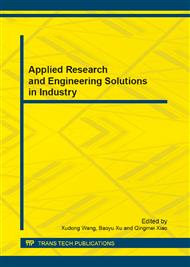p.406
p.411
p.415
p.421
p.425
p.429
p.433
p.438
p.445
Fourier Transform Infrared Spectroscopy (FTIR) Study of ACQ-D Treated Chinese Fir with Different Post-Treatments
Abstract:
Iinteractions of copper and wood components in the ACQ-D treated Chinese fir (Cunninghamia lanceolata Hook.) after hot water and hot air post-treatments were studied by using Fourier transform infrared spectroscopy (FTIR). Compared to Chinese fir (Cunninghamia lanceolata Hook.) without any treatments, significant reduction was noted at 1735±5 cm-1 assigned to carboxylic groups in the hemicellulose in all the samples with different post-treatments. The intensity of bands at 1655±5cm-1, 1510±5 cm-1 and 1265±5cm-1 are assigned to ketone carbonyl stretching groups, aromatic skeletal vibration and acetyl ether linkage in lignin were also decreased after different post-treatments compared to untreated Chinese fir. These results imply the fixation reactions of copper in the treated wood have been promoted by the post-treatment conditions, and the major bonding sites of copper in the treated wood are located in the wood lignin and hemicellulose.
Info:
Periodical:
Pages:
425-428
Citation:
Online since:
February 2013
Authors:
Price:
Сopyright:
© 2013 Trans Tech Publications Ltd. All Rights Reserved
Share:
Citation:


